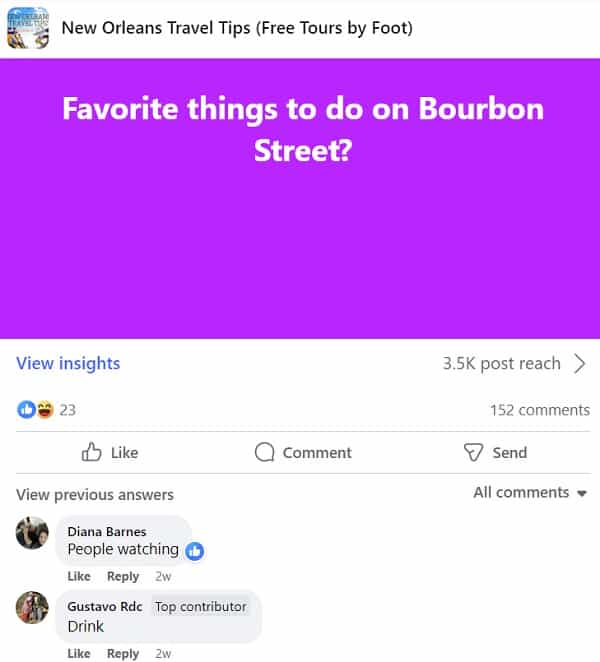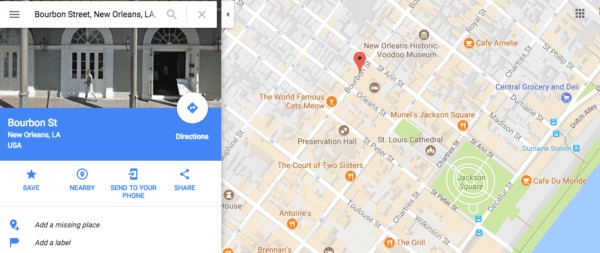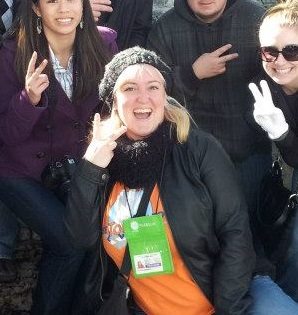This post is about things to do on Bourbon Street in New Orleans, LA. We include famous sights, places to eat, and places to hear great live music.
And, as Andrew, a tour guide with Free Tours by Foot demonstrates in the video below, there is much more to Bourbon Street than alcohol and music.
As local tour guides, we spend a lot of time on and around Bourbon Street, maybe a bit more than we locals like to admit :).
We lead thousands of visitors each month through the French Quarter and field questions about Bourbon Street on every tour.
And, we have used our experience and expertise as guides to help write this post.
We have asked the roughly 50k members of our popular New Orleans Travel Tips Facebook group what they thought of Bourbon Street.
And boy did they provide their opinions.
The group consists of locals, such as our tour guides, regular visitors to NOLA, as well as newbies.
There's no need to become a member of the group in order to read the posts, comments, and recommendations.
So, check out the group once you are done reading this post.
- Plan Your Visit
- Famous Sights
- Restaurants
- Bars with Live Music
- The French Quarter
- Things to Do in NOLA
PLAN YOUR VISIT
Bourbon St. is a mere 13 blocks long and yet is known worldwide for its drinking establishments, live music venues, souvenir shops, and much more.
It is so famous that more bars in the world are named after it than after any other place.
It also has plenty of restaurants and music venues, making it a perfect place to spend an evening. For other suggestions, see our post, Things to Do in NOLA at Night
For the best experience, start your walk on Bourbon Street at Canal Street and walk north until you reach St. Philip.
Along the way, you will see how the street's atmosphere changes.
It starts with a brass band playing most nights at Canal Street playing to tourists, including bachelor and bachelorette parties.
A few blocks farther, you’ll find yourself among upscale restaurants and historic bars, followed by a few strip clubs.
Then you come to a stretch of music venues until St. Ann Street, where there are a few gay bars, patronized by locals as well as visitors to NOLA.
When the street intersects with St. Philip you reach the last bar, Lafitte’s Blacksmith Shop.
Beyond Lafitte’s, Bourbon Street is residential for a few blocks until the end in the Faubourg Marigny neighborhood, just outside the French Quarter.
How to Get Here
Bourbon Street is conveniently located in the heart of the French Quarter and runs from Canal Street on its southwest side to Esplanade Avenue on its northeast side.
It is just 4 blocks north of the Mississippi River and 2 blocks north of Jackson Square.
It’s easily reached by foot from most lodgings in the French Quarter. (See the top reviewed area hotels from according to TripAdvisor).
If you are staying in another part of the city, there are several bus stops and cable car stops nearby.
Here’s a map showing New Orleans’ system of buses and streetcars.
Be sure to also read our post on how to ride the streetcar.
Let Us Take You Here
Bourbon Street is a stop on our guided tour of the French Quarter as well as our self-guided tour.
It's also a stop on our GPS-led audio tour of the French Quarter. Take a listen to the Bourbon Street clip.
Stay Here
There are several large hotels on or near Bourbon Street, like the Royal Sonesta, the Four Points Sheraton, and the Bourbon Orleans Hotel.
You can also find smaller places to stay, like the Lafitte Guest House, located right next to Lafitte’s Blacksmith Shop on the “quiet” (i.e., sometimes quiet) end of Bourbon.
The Olivier House, a locally owned hotel one block off Bourbon, has one of the best historic interiors in the French Quarter.
Check out some of the top reviewed area hotels as per TripAdvisor.
FAMOUS SIGHTS ON BOURBON STREET
Below are essential sights to see to understand more about Bourbon Street’s history and culture.
We have separate sections in this post on restaurants, bars, and live music venues.
The Olde Absinthe House
Open since 1807, this is the oldest bar on Bourbon Street, often given legendary credit for being where Andrew Jackson, Major General in the Battle of New Orleans, met to discuss strategy with Jean Lafitte, head of the local pirates.
Besides the availability of (non-hallucinogenic) absinthe, the walls are papered with the business cards of countless past visitors, and the building has some serious 19th-century character.
You can also explore the adjoining bar, Belle Epoque, which takes that 19th-century atmosphere in a more upscale direction, plus a food menu.
Mardi Gras Museum at Arnaud’s
When Arnaud’s - one of the neighborhood’s vintage Creole restaurants - is open, you can request to visit their upstairs display of Mardi Gras costumes, worn to past balls by members of the owning family.

“Museum” is a stretch - for a true museum on this subject, visit the Presbytère in Jackson Square.
But, it’s definitely one of the hidden gems of the neighborhood, and a drink at Arnaud’s bar is reason enough to get in.
Check out our post on Mardi Gras to learn about other Mardi Gras-related places and activities.
Musical Legends Park
On the third block of Bourbon, an unexpected fenced park appears, surrounding a location of local chain Café Beignet, which forever competes with Café du Monde in the city’s ongoing unofficial best beignet contest.
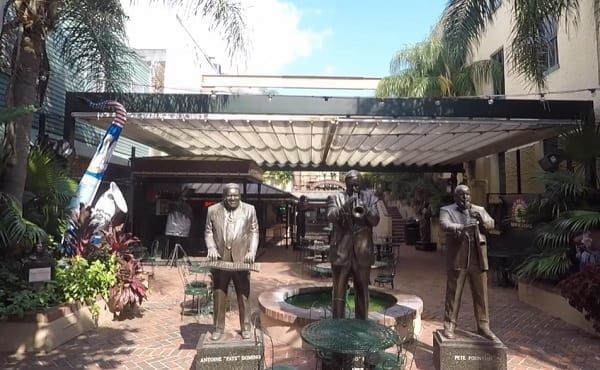
Live jazz performances by traditional jazz bands are common here - the only spot for outdoor jazz (and one of the few places for jazz at all) on Bourbon.
Also remarkable - the park has a public bathroom, a rarity in the French Quarter.
The name of the park comes from its statues of famous New Orleans performers, including Pete Fountain, Louis Prima, and Allen Toussaint.
The Chris Owens Club
The Chris Owens Club can seem a little out of place on Bourbon today - there’s a band, but it’s not exactly a music venue, and there’s a show, but it isn’t a strip club.

It’s one of the few vestiges of what Bourbon was like in the late 50s when burlesque and variety shows were the street’s mainstay.
Even more remarkable, as of 2019, the founder and namesake are going strong, well into her 80s, and still giving (fully clothed) performances most Friday and Saturday nights.
Posters from her shows cover the wall on St. Louis Street, and the show itself is like nothing else on Bourbon.
Also not to be missed: the owner’s annual Easter parade.
Former Location of Big Daddy’s
Once the premier adult entertainment venue on Bourbon Street, Big Daddy’s closed in 2014.
But its famous exterior calling card - a pair of legs wearing high heels, appearing and disappearing on a swing - still call the attention of passersby at the current establishment.
Marie Laveau’s House of Voodoo - 739 Bourbon
Here, the voodoo religion - one of the most misunderstood elements of New Orleans’ history - meets up with the oohing and ahhing crowds of Bourbon Street, and the result is a mélange of African art, genuine religious paraphernalia, and Hollywood-flavored souvenirs.
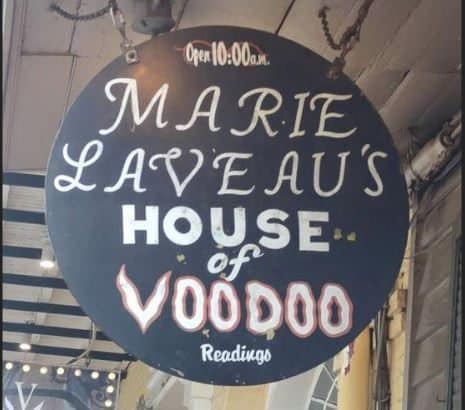
The former home of the shop’s namesake, Marie Laveau, is just a couple of blocks around the corner on St. Ann Street, and you can also find a couple of nearby establishments - Voodoo Authentica at 612 Dumaine and Conjure New Orleans at 506 Dumaine - owned and operated by members of the religion.
For more on this subject and to separate superstition from the little-known facts, take our daily, pay-what-you-wish Voodoo Tour.
RESTAURANTS ON BOURBON STREET
New Orleans has a fantastic food scene where you can find a variety of cuisines.
You should definitely try foods the city's specialties which we list in our post on 13 Must-Eat NOLA Foods.
Below are our favorite restaurants on and around Bourbon Street.
TIP: A good way to sample the city's delights and learn some history as well is to take one of our pay-what-you-wish food tours.
Red Fish Grill
Along with Bourbon House below, this is the famous Brennan restaurateur family’s contribution to Bourbon Street.
While the area is famous for seafood, the Quarter tends to serve quite a lot of it fried.
Red Fish Grill has a broad choice of seasonal grilled seafood, so it’s simultaneously one of the more delicious and healthier options in the neighborhood.
Bourbon House
Another offering from the Brennan family, Bourbon House covers a gamut of Creole fare with an emphasis on seafood.
One of the few places on this street where you’re actually likely to drink the beverage the street shares its name with.
Besides their wide selection of bourbons, they’re famous for their Bourbon Milk Punch cocktail.
Galatoire’s
Over a century old, this fine dining restaurant is an institution of Creole cuisine and one of the main forces pulling locals to the French Quarter.
It’s particularly known for its Friday lunch; the admission line starts before dawn and would-be patrons often hire someone to stand in line for them. (Other days are less competitive.)
The dress code is business casual in the daytime and formal after 5 as well as all day Sunday.
For a more casual atmosphere, try the bar at Galatoire’s 33, the restaurant’s newer bistro.
Clover Grill
At the opposite end of the street and the spectrum from Galatoire’s, this greasy spoon joint is known for burgers cooked under hubcaps, a local clientele, and spontaneous jukebox sing-alongs.
The definition of hangover food, and given its position near the end of the party strip, it’s probably prevented as many as it’s cured.
NOLA Poboys - 908 Bourbon
Open as late as 3 am depending on the day, this place is in the no-frills style of the city’s classic po boy specialists and offers a few dozen varieties of the long local sandwich.
These restaurants are on streets just off Bourbon Street.
GW Fin’s - 808 Bienville, one of the top-rated restaurants in town, upscale seafood specialist that always determines its menu by the catch of the day.
Arnaud’s - 813 Bienville, another Creole fine-dining stalwart - Remoulade, its bistro, and French 75, its bar, are both more casual.
Restaurant R’evolution - 777 Bienville, an upscale establishment in the Royal Sonesta Hotel, rooted in Creole tradition but with lots of modern twists.
Erin Rose - 811 Conti, an Irish bar known for its Bloody Mary and Irish coffee (hot or frozen), plus a backroom location of Killer Poboys, a po-boy purveyor with unconventional but locally inspired recipes.
Ali-Bobas – 734 St. Peters. Bourbon Street locals, bar employees, and those tourists in the know stop at this counter-service joint. Their Gyros are served quickly and are delicious.
Be sure to check out these posts on New Orleans food:
- Where to Eat the Best Gumbo in New Orleans
- Difference between Cajun and Creole Cuisine
- The Best Beignets in New Orleans
- The Best Po-Boys
BARS & CLUBS WITH LIVE MUSIC
Besides drinking, music is the one throughline of Bourbon Street from top to bottom, although the sound is different at different points.
Bourbon Street is so much more than the jazz, blues, and zydeco that has made NOLA famous.
You can hear cover bands playing pop/top 40 music, listen to dueling piano joints, sing karaoke houses, and more. Many bars have live music as well.
Below we list some bars and music venues that are standouts. They’re arranged in the order you’d walk by them, starting from Canal Street and heading north along Bourbon Street.
Note that other than Preservation Hall, none of the venues regularly charge for entry!
The 21st Amendment
Tiny cocktail bar, just a few steps off Bourbon but invisible to most bar hoppers. Various genres throughout the evening.
The Jazz Playhouse
Upscale cocktail bar with food options from Restaurant R’evolution next door.
Wide variety of music, usually one show per night, starting around 8:00 pm, plus an 11:00 pm burlesque show on Fridays.
The Bombay Club
The atmosphere and menu are a bit strange for New Orleans- think English club- but the music is generally chill traditional jazz, one to three pieces, and occasionally funk.
One show per night around 8. A good place to be able to both listen and converse. Known for martinis.
The Starlight
This cocktail bar is built into a space that still looks like the French Quarter residence it used to be.
There’s a kitchen in the back in the evenings, and the music gets going around five and continues well into the night.
The Tropical Isle Bayou Club
The only venue in the French Quarter that exclusively plays Cajun/zydeco music, the fiddle and accordion sound of southwest Louisiana.
Part of the Tropical Isle chain and so they’ll have the signature hand grenade drink.
Preservation Hall
Small and dingy but iconic, Preservation Hall is home to one of the world’s best traditional jazz bands.
Unlike the other venues on this list, Pres Hall isn’t a bar and has ticketed entry, so it takes some planning in advance.
Read more from our detailed post on Preservation Hall.
Bourbon O Bar
This cocktail bar inherits some ornateness from its home, the Bourbon Orleans Hotel, but it’s still casual. Various genres of local music throughout the week.
Fritzel’s European Jazz Pub
Fritzel’s comes close to being the perfect embodiment of many people’s image of Bourbon Street - traditional jazz or swing, depending on the night, a bountiful bar, a courtyard out back, a gothy speakeasy with a password upstairs.
Oz
After Bourbon Street crosses St. Ann Street, the bars are predominately gay bars. Oz is two stories, 24/7, dance floor downstairs, balcony upstairs, gogo dancers on the bar.
Depending on when you show up, you might find a sweaty dance floor or a game of bingo.
Bourbon Pub
Right across the street from Oz is “the Pub.” More relaxed on average than Oz, with various kinds of shows upstairs – drag, burlesque, karaoke – depending on the night.
Café Lafitte in Exile
Founded in 1933 and still rolling, possibly the oldest gay bar in the country.
Here are some additional recommendations grouped by genre:
House cover bands
- The Famous Door - 339 Bourbon
- Razoo’s - 511 Bourbon
- Fat Catz on Bourbon - 440 Bourbon
Karaoke
- Sing Sing - 418 Bourbon
- Cat’s Meow - 701 Bourbon
Piano music
- Spirits - 615 Bourbon
- Ticklers - 635 Bourbon
- Pat O’Brien’s - 718 St. Peter
- Lafitte’s Blacksmith Shop - 941 Bourbon
TIP: For more information on NOLA's impressive music scene, check out our post on the Top Places to See Live Music in New Orleans.
Or sign up for our New Orleans Music and Arts Tour, which generally runs on Fridays and Saturdays with other days sprinkled in by season.
For more about drinking in New Orleans, check out these posts:
- 12 Must-Try New Orleans Cocktails
- New Orleans Cocktails and Drinking Guide
- Self-Guided Cocktails Drinking Tour
HISTORY OF BOURBON STREET
Bourbon Street has had its name since the beginning when the city was laid out following its founding in 1718.
The bars, on the other hand, are a thing of the late 19th century and beyond – before that, it was a quiet, respectable, middle-class street.
If you squint through the neon, you can see buildings that would have served as businesses downstairs with owners upstairs, and the size of those residences was one of the factors that led Bourbon to be an ideal bar corridor when the time came.
Given that timing, the name has nothing to do with alcohol.
Coincidentally, both Bourbon Street in New Orleans and Bourbon County in Kentucky were named for the same thing: the Bourbon monarchy, which ruled France at the time when it was putting its colonial touch on this region.
And coincidentally, both of those areas independently became famous for alcohol – this one for its bars, that one for its whiskey.
But nightlife strips have been a constant in New Orleans history, as in any port city, and Bourbon Street is only one of the more recent places where nightlife has taken up residence.
One previous area was Iberville Street, which crosses Bourbon near its beginning, and in the 1890s, there were a few piano bars on Bourbon’s first couple blocks, even as most of it remained residential.
In 1920, the beginning of Prohibition (America's legal ban on alcohol, which lasted for fourteen years) wildly shifted the business model for nightlife, and buildings on Bourbon began to be converted into private nightclubs.
The next burst of activity came with World War II, when a huge portion of the US military, on leave from bases in the area or shipping out through the port, spent time in the French Quarter.
These unintentional tourists became intentional tourists after the war, and between the 40s and 60s, the street exploded to its current length and became famous for jazz, burlesque, and organized crime.
Unfortunately, it was the crime more than the jazz and burlesque that made the bars profitable, and after a crackdown in the 60s, a shift to recorded music began, which remains part of today’s patchwork music scene; jazz’s era as mainstream American music also passed, and Bourbon Street adjusted to commercial demand by adjusting its repertoire.
Some see this as a decline, but as far as its viability, Bourbon Street is unquestionably going strong.
Its bartenders and dancers were among the first people back to work after Hurricane Katrina, and it continues to flourish through the constant shifts New Orleans has seen in the 21st century.
How Bourbon Street Is Different
There are a few things that set Bourbon apart from most party districts. One is the presence of New Orleans’ distinctive alcohol laws, or, in many cases, lack thereof.
Most noticeably, it’s legal to drink in the street anywhere in Orleans Parish, which includes most of the city, although in the French Quarter, you’re supposed to ask for a go-cup before you go outside (rather than carrying glass or metal in the streets).
It also means the bars aren’t obliged to close, and 24-hour bars are common.
The freedom to carry a drink outside means the party is both indoors and outdoors under almost any weather, leading to a culture of people-watching and a business model based mainly on grabbing attention.
So the drinks for sale here tend to be flashy - bright-colored frozen daiquiris, “hand grenades” in tall novelty cups, glowing skulls, and fishbowls almost too large to wrap your hand around.
TIP: Learn more about drink history through our French Quarter cocktail tour.
Another piece of distinctiveness is the fact that all of Bourbon’s businesses are built into 19th-century Creole architecture protected by historical regulations, giving a museum backdrop to the strip’s party character.
Your exploration may bring you into old residences, courtyards, former carriage houses, and slave quarters.
A fixture of Creole architecture is balconies, and many of the bars offer second-floor access.
For those on the balconies, it’s a popular pastime to throw Mardi Gras beads (regardless of the time of the year) at passersby below, and those passersby can choose whether to invite or dodge these projectiles.
For more on Creole architecture and neighborhood history, try our guided tour of the French Quarter, our self-guided tour, or our audio tour.
RELATED POSTS





